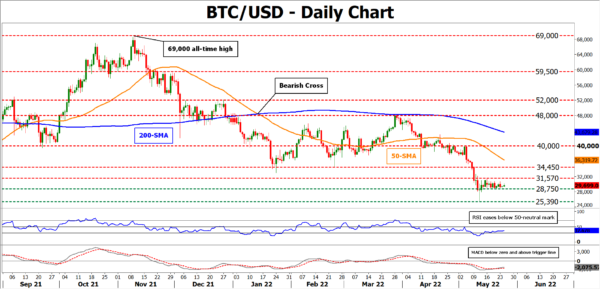Bitcoin has delivered its eighth consecutive weekly loss for the first time in history, currently trading in a tight range around the $30,000 psychological mark, which is more than 50% down from its all-time peak. The sustained downtrend could be attributed to a barrage of emerging headwinds such as the negative macroeconomic environment for risky assets, inflation and growth concerns, alongside idiosyncratic risks stemming from within the crypto industry. Heading further into 2022, Bitcoin and the broader crypto market seem to be lacking the necessary catalysts that could drive upside growth, but cryptocurrencies have managed to recover from all their previous downfalls. Is this time any different?
Further decline or imminent reversal?
In recent months, investors appear to be moving away from cryptocurrencies and risky assets in general in the face of persistently high inflation and recession fears. Any signs that inflationary pressures are not waning would force central banks to slam the brakes harder on the economies, infusing further downside pressures into the crypto space. Moreover, the collapse of Terra and Luna has increased uncertainty, while a new systemic failure might act as the final blow to investors’ interest in the unregulated cryptocurrency sphere.
On the other hand, a recent report by the United States Federal Reserve Board revealed that most US crypto investors trade them for profit-gaining purposes, neglecting their use as an alternative payment method. Essentially, the current situation in crypto markets could endorse a buy the dip strategy, which could be further bolstered by speculators joining in to push the market higher and exploit the bull run. Furthermore, crypto funds, institutional investors and asset management firms are now having a significantly higher stake in cryptocurrencies than retail traders, with most of them having stepped in the market at higher levels. Thus, it is clear that they would do anything in their power to avoid a long-lasting crypto winter.
Congress to introduce the first regulatory framework
There are growing threats of a regulatory crackdown hanging over crypto markets since the collapse of two major altcoins earlier this month. In response to the increasing calls for regulatory action, US policymakers are expected to put forward a bill that will categorize cryptocurrencies as either securities or commodities and announce which public agency will be responsible for their oversight. In addition, the proposed legislation will include provisions covering consumer protection from fraud and taxation issues. Undoubtedly, the passage of a clear and strict regulatory framework for crypto assets will be a sigh of relief for investors, reducing uncertainty and motivating adoption.
Bitcoin rangebound unable to find fresh trading impetus
Bitcoin price has been trading within a tight range during the past week, with the decline in volatility probably hinting that investors are scrutinizing the current complex market conditions to decide its future price direction.
Should major central banks tone down their hawkish rhetoric and try to perform ‘softer’ landings, the bulls could initially target $31,570, which is the upper boundary of Bitcoin’s recent sideways move. Piercing through this barrier, the $34,500 hurdle could prove to be the next resistance point.
On the flipside, signals of a faster tightening cycle may send the price to test the recent low of $28,750 before the spotlight turns to the 2022 low of $25,390.















